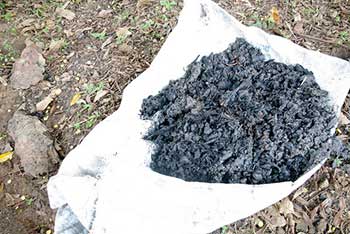6 Practical Uses for Wood Ash Around the Homestead

Burning your scrap wood in the winter months can provide a source of heat and an opportunity to gather friends and family around the fire. It’s a great way to clear brush build up and keep your home warm on cold evenings, but why stop getting good use out of your wood there?
Wood ash has been around for hundreds of years as a useful and natural ingredient to use as a resource around the house and outdoors. With the power to boost nutrient levels in soil, repel insects, and more, wood ash is a hardy staple of any savvy homesteader and was even appreciated by our forefathers. In fact, a handy bit of wisdom you can use to impress your friends is that the method of using wood ash as a fertilizer was the first U.S. patent.
1. Wood Ash for Nourishing Plant Life
If you’ve been researching ways to infiltrate your soil with some helpful nutrients, you’ve probably come across a bevy of commercial lime treatments. Wood ash is a natural and easy way to treat your soil and boost its acid levels—and you and your plants can enjoy the nutritious benefits without a trip to your local garden center.
Wood ash is superior to lime in other ways as well. The amount of nutrients returned to the earth from wood ash are much greater and diverse. Wood ash is a wonderful source of lime, potassium, calcium, and a plethora of other essential nutrients for plant growth.
If you’re thinking your garden could use a beneficial boost, the first step in treating your soil is with a pH test. If you find that your levels are low in acid, then a wood ash sprinkling around your yard could do your plant life some good.
Wood ash from hard wood is the best to use when it comes to treating your soil and adding nutrients. This is mainly due to the fact that hard woods contain more nutritional substance.
The amount of wood ash that you will need to apply will be anywhere between one and a half to twice as much as the recommended lime treatment. To add to the soil, sprinkle lightly and gently rake into the soil making sure not to damage any root systems.
You can use this treatment in flower beds, on lawns, for shrubs and even for aquatic plants. For your water plants, add one tablespoon per 1,000 gallons of water. Tomatoes love the extra calcium boost too. Wood ash can help protect plants against frost, but use in the springtime can be tricky because young plants often can’t take the drastic change in pH.
Use your wood ash in the fall for best results. If your soil is not poor in acid, then it is probably safer to forego any wood ash treatment. Certain plants thrive in low acid conditions. These include blueberries, rhododendrons, mums, marigold, oak, potato varieties, azaleas, and more.
2. Compost
A sprinkling of wood ash adds nutrients to compost and also helps to balance and stabilize the conditions of the compost for optimal microorganism growth. A little goes a long way, so be sure to use a light sprinkle of wood ash every once and awhile instead of a large dose of this powerful compound.
3. Insect Repellant

If you have an alkaline soil, you may be able to use wood ash liberally enough to even control your pests with it. Wood ash draws water from the bodies of invertebrates such as ants, snails, slugs, and other insects. For this purpose, apply dry wood ash to problem areas or around plants that you wish to protect.
4. Odor Remover
Wood ash can also be a powerful odor remover. Use it in hard-to-bust areas like in the kitty litter box or place a mound of the stuff on a plate in the fridge to rid yourself of unpleasant odors.
5. Make Soap

>By combining wood ash and water, lye is produced. If you’re a veteran homesteader, then you know that lye is a main ingredient in making your own soap. You’ll need to add in animal fat and boil the mixture to create a final product. A bit of added salt will make the soap harden as it cools.
Since soap making can be a complicated and sometimes dangerous endeavor, make sure to find detailed instructions and to take proper safety precautions.
6. Melt Ice
 You can even start utilizing your wood ash in the winter with this great hack. Melt away ice, free your car from a slick spot, and clear your walkways with the use of wood ash. The salt and acidic properties of wood ash make it the perfect solution to melt the ice on your sidewalk, porch, or even the street. Keep a little in your car to use when your tires slip to add some traction and avoid dumping more salt on the roads.
You can even start utilizing your wood ash in the winter with this great hack. Melt away ice, free your car from a slick spot, and clear your walkways with the use of wood ash. The salt and acidic properties of wood ash make it the perfect solution to melt the ice on your sidewalk, porch, or even the street. Keep a little in your car to use when your tires slip to add some traction and avoid dumping more salt on the roads.
Use Caution
Before using wood ash in and around your home, there are a few considerations you should make when it comes to handling and treating with this powerful solution.
-Wood ash is a strong material, so always handle it with care. Eyewear and gloves are necessary when working with wood ash. If the ash is small and dust-like, a dust mask can help to prevent bodily harm.
– Be careful whenever burning wood around the home. Always remove ash from an oven or pit with a metal bucket and store securely to avoid fires.
– For the above uses, be sure that your source of wood ash is pure. Ash from burnt trash, cardboard, coal, or any kind of treated, painted, pressurized, or stained wood should not be used for any of the above purposes as they may contain harmful elements and sometimes toxins.
– When neutralizing soil and balancing acid levels, make sure never to use with nitrogen fertilizers in combination with wood ash. A mixture of nitrogen and highly acidic properties such as wood ash produces ammonia gas.
 Home and Gardening Ideas At home and Gardening ideas we believe inspiring readers about homesteading, self sufficiency
Home and Gardening Ideas At home and Gardening ideas we believe inspiring readers about homesteading, self sufficiency





